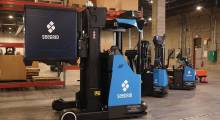Optimism for the manufacturing and non-manufacturing sectors, in 2019, is firmly intact, albeit not at the same level as 2018, according to the Institute for Supply Management’s (ISM) Semiannual Economic Forecast, which was released this week.
Data for this report is based on feedback from U.S.-based purchasing and supply chain executives in manufacturing and non-manufacturing sectors.
For manufacturing, ISM is estimating a 5.7% gain in 2019 revenue, which trails the 5.8% revenue gain for 2018. And it said 64% of ISM survey respondents expect 2019 revenues to be higher than 2018. Revenue growth in 2019 is expected in 17 of the 18 manufacturing industries.
2019 manufacturing capital expenses (capex) are expected to head up 6%, which is down from the 13.4% increase in 2018 over 2017, and 41% of respondents expect 2019 capex to rise at an average of 32.5%, with 40% expecting it to be the same as 2018, and 19% say it will be lower. Capacity utilization, which came in at 85.2% is in line with the report’s previous reading of 85.8%, and production capacity is estimated to increase 4.7% in 2019, slightly trailing the previous estimate of 4.9%.
Raw materials prices are expected to head up 3.3% in 2019, coming off of a 5.1% gain in 2018. Manufacturing employment is expected to head up 2.4% in 2019.
“Manufacturing is finishing the fourth quarter on a strong note and is flowing into the first quarter on that same level,” said Tim Fiore, chair of the ISM’s Manufacturing Business Survey Committee. “The positive expansion cycle will likely continue into the second quarter. The second half of 2019 is a little different, with some indications of some softening. That is not surprising, as the manufacturing expansion is at about 27 months so far, with the PMI bouncing across the top from 57 to 59 (a reading of 50 or higher indicates growth). At some point, we will see two or three months where we will see a decline in the expansion, which could happen in the second half of 2019.”
For non-manufacturing, the report expects revenues to rise 3.7% in 2019, which is below 2018’s 4.5% gain, and 17 of the 18 non-manufacturing sectors calling for higher revenues, up from 16 in the previous report.
Non-manufacturing production capacity, or the capacity to produce products or provide services in this sector, is expected to increase 2.9% in 2019, up from 2018’s 2.4%, and non-manufacturing capex is expected to be up 3.4% in 2019, up from 2.8% in 2018.
Prices paid for non-manufacturing are expected to increase 3.6% in 2019, which is ahead of 2018’s 2%, and non-manufacturing residents said that their purchases over the first five months of 2019 will be up by an average of 3.2% compared to the end of 2018. Non-manufacturing capacity utilization, or the operating rate, at 88.4%, is above May’s 84%, and non-manufacturing employment is expected to increase 2% in 2019.
“As we look at the report, coming off of such a strong year in 2018, the prevailing feeling from our respondents going forward into 2019 is that it is not going to be quite as strong,” said Tony Nieves, chair of the ISM Non-Manufacturing Business Survey Committee. “That means we will have a little pullback in the non-manufacturing sector in 2019, which is what our respondents have been telling us along. There are no signs of recession at this juncture.”
Addressing capex, Nieves said that going back to 2017 and early 2018, respondents were very optimistic, and growth remains expected for 2019 despite the threat of tariffs. And the non-manufacturing employment outlook, he said, has been impacted by a reduction in the skilled worker labor pool.







